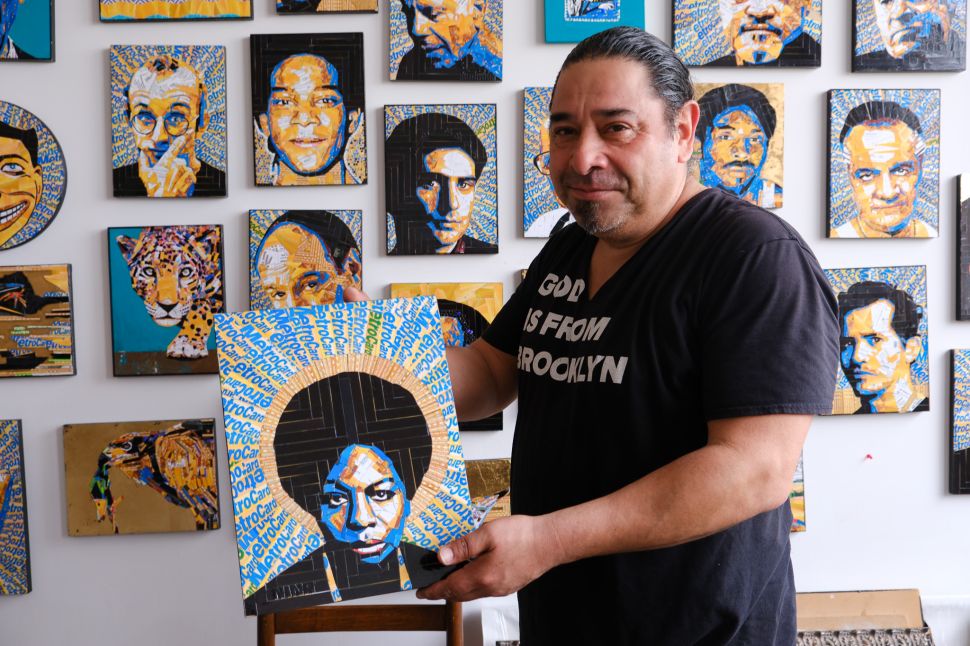Juan Carlos Pinto, holds a MetroCard mosaic portrait of Nina Simone while standing in front of a wall filled with his other mosaic portraits.” width=”970″ height=”647″ data-caption=’Juan Carlos Pinto holds a MetroCard portrait of Nina Simone. <span class=”lazyload media-credit”>Photo by Jamie Lubetkin</span>’>
The Metropolitan Transportation Authority’s recent announcement that it will stop selling the iconic yellow MetroCards by Dec. 31 came as heartbreaking, though not unexpected, news to a small but passionate community of artists who use the credit-card-sized passes to create surprisingly engaging works of creativity. Giving new meaning to the term “underground art,” MetroCard art has thrived in New York ever since the cards replaced metal tokens as the city’s essential transportation appliance 32 years ago. Now, its days are numbered.
Brooklyn-based artist Juan Carlos Pinto has been at the vanguard of MetroCard art for almost as long as New Yorkers have been swiping the cardboard passes. Leveraging skills he honed creating street mosaics, Pinto painstakingly carves the cards into tiny shreds, then applies them to canvas to create portraits of artists, politicians, entertainers, sports stars and others.
On the wall in his Flatbush studio: Barack Obama, Keith Haring, Jean-Michel Basquiat, Will Smith, David Bowie, Pelé, Tupac Shakur, to name a few. There are also birds, landscapes and artworks, including da Vinci’s Mona Lisa and Vermeer’s Girl with a Pearl Earring.
“I have a little stash, about 10,000 cards,” Pinto says wistfully, contemplating the day when his cherished medium will be no more. At his current rate of production, about one piece per month, he figures he has enough to keep at it for another five years.
Pinto has lived in Flatbush for over 25 years in a home he purchased with proceeds from his artwork. “The garbage of New York City paid my mortgage,” he said, remembering the years he spent scooping up discarded cards from the floors in subway stations.
Another long-time collector of discarded MetroCards is East Village artist Thomas McKean, who has been crafting intricate mosaics and three-dimensional constructions from the transit refuse for more than 20 years. Like Pinto, McKean’s process involves meticulous cutting, sorting and reconfiguration to transform the cards into complex visual compositions.
“One day, I forgot my newspaper, and I saw a poster about the MetroCard, which was still kind of new, and I started wondering how many words I could make from the word MetroCard. When I got home, I cut up some MetroCards and began reassembling the,m and I was hooked. I branched out from there,” McKean told Observer, describing his entry into the MetroCard art world.
Since then, MetroCard art has overtaken every inch of his East Village apartment. There are renderings of monsters, animals, people, his ancestors, events from his life along with tiny 3D recreations of buildings and other structures. And of course, there are thousands of MetroCards in overflowing boxes and bags. Like Pinto, McKean figures he’s husbanded away about five years’ worth of materials.
The palette afforded by MetroCards might seem limited—predominantly yellow backgrounds and blue text, some highlights in gold and brown, with white and a black magnetic strip on the back—yet artists have discovered remarkable versatility within these constraints. The age of the cards, exposure to light and various print runs all contribute to a much wider palette of colors: the ubiquitous yellow, for example, can present as anything from lemon chiffon to ochre.
The MetroCard art scene extends beyond these individual practitioners. The “Single Fare” gallery exhibition series, initiated in 2010, brought together hundreds of artists who created miniature masterpieces on the cards. These shows revealed an astonishing diversity of approaches: some artists completely transformed their cards with gesso or paint, while others exploited the cards’ physical properties through techniques like contour-line carving or folding.
Nina Boesch, whose MetroCard mosaics reimagine iconic New York landmarks and symbols, has kept the art form alive through educational outreach. In June, the New York Transit Museum hosted one of her hands-on workshops in which participants learn her creative process while creating their own MetroCard masterpieces—a bittersweet celebration on the eve of the medium’s retirement.
For some New Yorkers, the disappearance of MetroCards represents more than just the loss of a medium—it symbolizes New York’s relentless march toward digitization at the expense of tactile, analog experiences. These small rectangular cards were New Yorkers’ constant companions, tagging along in pockets and purses while waiting to exercise their utilitarian purposes. That they would become democratized canvases that reflected the city’s DIY ethos and streetwise ingenuity is hardly surprising.
SEE ALSO: U-Haul Gallery’s Mobile Model Takes Art to the Streets
The irony isn’t lost on these artists that their medium was itself a technological replacement for another New York transit icon—the subway token—which was phased out in 2003. That evolution in fare payment technology left cultural artifacts that artists continue to use today in the creation of jewelry and other keepsakes.
While some MetroCard artists view the coming fare card obsolescence with resignation, others see opportunity in scarcity. As supplies dwindle, existing MetroCard artworks may appreciate in value since no more can be created. A collectors’ market already exists for the more than 400 special edition MetroCards issued over the years, with particularly rare specimens fetching surprising sums online.
For artists like Pinto and McKean, the challenge is whether to hoard their remaining supplies, racing against the MetroCard’s extinction, or to embrace new materials and forms. Both said they plan to explore alternatives during the final years of the MetroCard run.
As New York’s subway system evolves toward a frictionless future, these artists preserve fragments of a tactile past—each MetroCard masterpiece contributing to the preservation of an urban legacy, a marker in the history of an ever-transforming metropolis, maybe even a small rebellion against time’s relentless tide.

